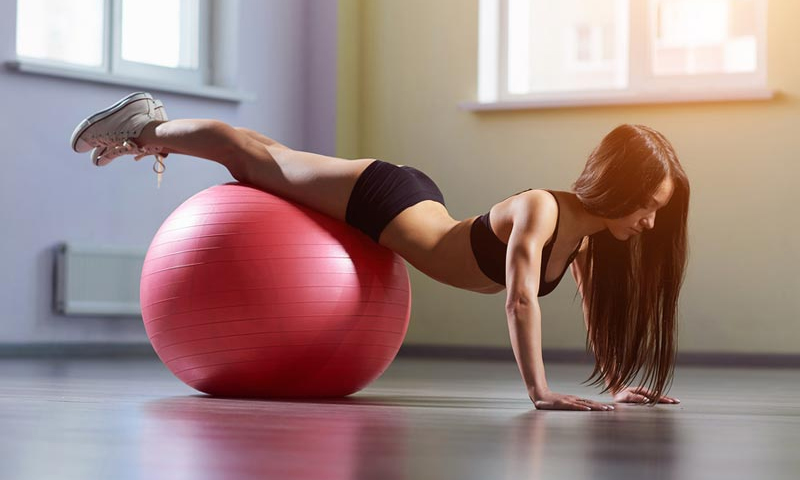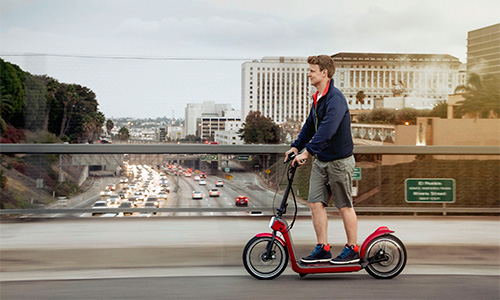The popularity of fitballs and their widespread use are forcing more and more people to become interested in this gymnastic ball. Coming to a specialty store, among the shelves with sports equipment, people who are not knowledgeable about the subject can easily get lost, choosing the first trainer that came to hand. Only at home, having started training, they understand that they did not buy the fitball at all. In fact, in the selection of this ball is nothing complicated, it is enough to know your weight, height, as well as the result that you want to get in the process of training. Our material tells about the types of fitballs and the main parameters (reliability, size, elasticity, color, etc.), based on which you should make a choice.

Content:
The best manufacturers of fitballs - which company to choose
In the domestic market of sports equipment today presents a lot of gymnastic balls of various sizes and colors. Almost all companies in this segment have at least one product line in their range.
Manufacturers put on sale both budget and expensive products, so the buyer can choose from. Trainers recommend purchasing quality fitballs, giving preference to large firms. Reliable are balls made in Germany, America, Italy and several other countries.
Here are just some brands that have won the trust of professionals and consumers:
- Reebok;
- Togu;
- Ledraplastic;
- Bradex;
- Indigo.
Gymnastic balls made of the best materials, in compliance with all technological requirements, can serve as long as possible. At the same time they will be completely safe and will not cause harm to health. This is especially important for pregnant women, as well as for parents who are looking for a simulator for the child.
Products must be certified. Ask the sales consultants for supporting documentation or look for information on the manufacturer's website, and only then go to the store for a purchase.
Everyone who wants to find the right model right now, we suggest moving to our rating of the best fitballs.
The principle of operation and fitball device

Fitball is a large-diameter ball used in various recreational and gymnastic exercises. It was invented by a doctor, and was initially used exclusively for the treatment and restoration of the body. Only later his range of applications expanded to sports activities.
This simulator is perfect for all groups:
1. Children, including babies;
2. Expectant mothers;
3. Sedentary people;
4. Complete;
5. Patients with cardiovascular diseases;
6. Older people.
Fitbol possesses elasticity and durability, and it is possible to work with it both independently at home and in a group under the guidance of a coach.
Externally, the ball is usually round. Its surface can be either absolutely smooth, or studded and bumpy (in massage models). The cost of fitball is inferior, for example, to a treadmill or stepper, although it has efficiency just as good.
Exercises with this projectile put pressure on all muscle groups, developing flexibility, dexterity and coordination. Correction of a bearing also occurs, calories are effectively burned, the tone is maintained.
Fitballs provide good therapy and prevention of the first stages of dystrophic and degenerative pathologies of the spine and joints. In addition, classes relieve stress, improve digestion and give a good mood.Due to the fact that there is no excessive load on the lower limbs, it is quite simple for older people with problematic joints.
Exercises on fitball are similar to riding, as the person sitting constantly needs to keep balance, and this process involves those muscles that usually do not work.
The oscillating ball stimulates the liver, stomach, kidneys and other internal organs. The impulses emanating to the brain accelerate the production of new conditioned reflex connections. Especially it helps children with intellectual and mental development.
Types of fitballs
Classic fitball (smooth)

This version of the gymnastic ball is most often used for practicing pregnant women and newborns, although it is suitable for other groups.
Such fitballs are used not only for training, but also for various relaxation techniques. The absence of any elements minimizes the risk of hematomas that may appear with an improperly selected simulator in people with small tissue swelling.
Advantages:
- suitable for everyone;
- gives the effect of relaxation;
- not contraindicated in pregnant women and newborns.
Disadvantages:
- No massage effect.
Massage (bumpy, with spikes)

Such fitballs have protruding bumps or spikes over the entire surface. In addition to all the properties possessed by the classic gym ball, this model also has a massage effect.
Especially well suited simulator to combat cellulite, stretch marks and subcutaneous deposits. No less excellent, he will cope with the treatment of various diseases of the spine. This ball can also be used for relaxation.
The only thing that needs to be traced is that the floors in the classroom are covered, on which a fitball with an uneven surface can easily move.
Advantages:
- provides a massage effect;
- it is used also for relaxation;
- copes well with the problems of overweight, cellulite and stretch marks;
- treats diseases of the spine.
Disadvantages:
- contraindicated in infants and people with swelling;
- may cause hematomas.
With horns or staples

Such balls for gymnastics are absolutely smooth, like classic models, but they have special handles either in the form of horns or in the form of braces. They are needed to maintain balance.
Most often, these fitballs are used in classes with children. This allows babies to sit on the ball and jump, without losing their balance. Inexperienced users also begin their exercises with fitballs equipped with handles.
There are special exercises that will require the use of horns or brackets for more convenient performance.
Advantages:
- ideal for children and inexperienced users;
- allow better balance;
- Suitable for a variety of special exercises.
Disadvantages:
- not found.
Fitball selection options

Durability and Reliability
First of all, pay attention to the seams: they should not be felt to the touch and be visible to the eye.
See if the fitball has an anti-explosion security system. It will help if the ball breaks tightness: the explosion will not occur, instead, the air will gradually be released outside. Usually on the product are signs ABS (Anti-Burst System) or BRQ (Burst Resistant Quality), which indicate the presence of this function.
It is also important that the surface is antistatic. Special supplements included in rubber are responsible for this. Thanks to them, the simulator will not be able to stick dust and debris, and the student will not get unpleasant electrostatic discharges.
Strength fitball provide thick six millimeter walls. True, the load on the sports equipment will still depend on the quality of the material and the weight category involved in the ball.
Models up to a thousand kilograms are perfect for strength training with barbells, dumbbells and other weighting, as well as for dynamic jumps.
Do not forget to check the certificates confirming the environmental friendliness of the material used.If a sharp chemical smell emanates from the fitball, then you should refrain from buying. Remember that poor-quality rubber will cool the skin, unlike warm products made from good raw materials.
Elasticity
Fitball shell can not be too pliable or with excessive surface resistance.
The perfect ball, when pressed, will bend no more than a couple of centimeters; after releasing, the springy surface will quickly restore its shape. On the surface of the simulator should not form any folds, no matter how much you try to pinch it.
The size
The diameter of the fitball should correspond to the growth of the one who will be engaged in it.
1. People up to 155 cm should choose a ball with a diameter of 45 cm;
2. People up to 170 cm - 55 cm;
3. People up to 185 cm - 65 cm;
4. People from 185 and up - 75 cm and more.
You can check the selection is right in the store, just sit on the ball and pay attention to the angle between the knee and hip joint, it should be about ninety degrees.
Colour
The coloring is in this case an important factor when choosing, as it has a great influence on the mood, emotional mood and well-being that a person will have in class.
Experts advise to choose calm colors:
1. Natural metallic;
2. Transparent;
3. Pale blue;
4. Pale pink;
5. Pale orange;
6. Light green.
Usually such a palette distinguishes a branded product, while low-quality balls are full of acidic and too bright colors.
What fitball choose

1. If you are in position, then choose the classic smooth fitball. He also should prefer for classes with newborn children.
2. Planning to get rid of cellulite and stretch marks? Then acquire models with spikes or pimples.
3. Exercise machines with handles are perfect for dynamic jumps and for exercises of children, as well as beginners.
4. Those who need to improve the spine, we recommend a massage fitball.
5. Choose products in which there is an anti-explosion security system and protection against static electricity.
6. For classes with weights you need to buy a ball that can withstand loads up to a thousand kilograms.
7. Give preference to fitball, whose wall thickness is at least six centimeters.
8. Buy exclusively elastic balls that are free of folds, wrinkles, and their shell does not sag in elasticity.
9. Choose calm colors that are slightly muted. Bright and acid are not recommended for purchase, as, most likely, such balls are not made of high-quality material.
10. Fitball should choose only one that is made of hypoallergenic materials.
11. For children and people of short stature, you will need balls with a diameter of up to 45 cm. Those with average and above average height should choose models from 55 to 75 cm and more.
How much does a fitball cost

1. Small diameter balls can be bought for 400-700 r.
2. Larger models will come out more expensive, you will have to pay about 1 thousand rubles for them.
3. Products with a massage effect (bumpy and studded) will cost approximately 1,500-2 thousand r, depending on the diameter and brand of the manufacturer.
4. Gymnastic balls with handles in the form of staples and horns for the price is not much different from the classic, smooth fitballs. Their purchase will cost about 800-1.500 p.
5. The thicker the walls of the fitball, the more expensive it will cost. Models for exercises with weighting can be purchased for 2-2.500 p.
It will be interesting to friends too









